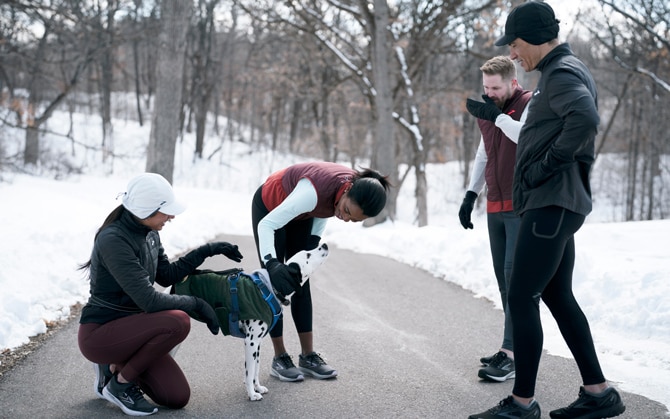How To Stop and Prevent Stitches When Running

If your run has ever been brought to a standstill by a throbbing pain in your side, then you’re not alone. That’s known as a stitch, and it’s an unpleasant sensation that can affect even the most seasoned of runners. But what is a stitch? Why do we get them? And – most importantly – how do you stop or get rid of stitches? Read on to find out everything you need to know.
What are stitches when running?
First things first: what is a stitch when running? Medically, stitches are known as ‘exercise-related transient abdominal pain’ - a bit of a mouthful!
Stitches usually cause a sharp, stabbing pain in the side, although some people also describe it as cramping or pulling just below the ribs. It can also cause pain in the tip of your shoulder.
They usually happen on one side of the body, and more often than not, they come out of nowhere. One minute, you’re cruising along enjoying the trails or heading for a PB, and the next moment, you’re doubled over in pain. There’s no doubt about it, stitches are extremely frustrating - and sometimes, they can even ruin your race.
What causes a stitch when you are running?
If you’ve ever wondered “why do I get a stitch when I run?”, we’ve got some bad news for you. There’s no clear explanation as to what causes a stitch in your side during running. There are, however, several different theories to explain why we get this type of pain, including:
A decrease in blood flow to the diaphragm
Your diaphragm is a muscle just below your lungs, and it helps you to inhale and exhale. When you run (or exercise in any way), more demand is placed on the diaphragm. The theory is that if the diaphragm is asked to work harder than it usually does, such as expanding and contracting faster than usual, it may result in a stitch. This is more common in beginner runners.
Spinal stress
Running can put a lot of stress on your spinal column, and so it’s thought by some experts that this added impact can manifest as shooting pains in your side. This may be more common in runners with a curved spine.
Parietal peritoneum irritation
The most popular theory behind why we get stitches is irritation of the parietal peritoneum. This is a thick membrane that wraps around your abdomen and pelvic cavities. Sensation in the parietal peritoneum is linked to the phrenic nerve, which helps to control your breathing. The theory goes that when you run, the muscles in your core and back become tired and start to over engage, pressing on your phrenic nerve. This then translates into pain in your abdomen, otherwise known as a stitch.

What triggers stitches?
No one is immune to stitches! Whether you’re embarking upon your first 10k training plan or are an experienced ultramarathoner, you may experience the dreaded muscle stitch on a run. But there are some things that seem to increase your chances of getting one while out on a run.
Not warming up properly
We can all be guilty of it sometimes - we just want to get out there and get on with our kilometers, whether we’re doing a quick speed session or a long run. But fail to warm up properly and you could run the risk of muscle stitches. A good warm up will warm up your body and promote proper breathing, getting you into a good rhythm for your run.
Eating right before your run
If you eat too much, too soon before your run could be another trigger for stitches. Try to avoid eating a heavy meal 1-2 hours before your run, as this can activate your GI system - resulting in less oxygen to your diaphragm. And if your diaphragm is getting less oxygen than it needs while you’re trying to push it hard on a run, you may end up with a stitch.
Going out too hard = stitches
Sprinting from the off may lead to side pains, as you haven’t given your body enough time to adjust. Take it easy for the first kilometer or so on your run to let your body settle into it, before you start to push the pace.
Not breathing properly
If you take shallow breaths when you run, then there’s a chance your muscles won’t get enough oxygen. This could mean that they become overly tired, causing cramps and stitches. Instead of shallow chest breathing, try taking belly breaths when you run. This type of breathing engages your diaphragm, allowing your lungs to expand fully and take in more oxygen.

How to stop stitches while running
So, you’re on the run and you’ve got a muscle stitch. Now what?
Often, the only thing that will make a stitch abate is to slow down. Slow to a walking pace until you feel the pain subside, then start to build back up to a run slowly.
As you’re walking along, practice some of those deep belly breaths to fill up your lungs and maximise your oxygen intake.
You can also try stretching as you move, either by stretching your arms overhead or by leaning forward to stretch your back.
Pressing on your side where you feel the sensation can also help to alleviate the pain.
Hopefully one of these techniques - or a combination of all of them - will help you to get rid of your stitch and continue running happy!
How to avoid stitches
Prevention is better than cure, so here’s how to stop stitches in their tracks:
- Don’t eat immediately before a run. Schedule your runs so that you’re not having a large meal 1-2 hours before you head out.
- Warm up properly. Your warm up should include dynamic movement like these pre-run stretches to prep your body properly.
- Start slowly. After your warm up, you should take it easy for at least a mile (or 10 minutes) to allow your body to adjust to the run.
- Ensure you’re properly hydrated. Hydration for runners is important for lots of reasons, and it’s thought that it can help to prevent stitches, too. Drink plenty of water in the 12 hours leading up to your run (but not too much in the 1-2 hours before, to avoid your stomach becoming bloated and pressing against your parietal peritoneum).
- Strengthen your core. A stronger core may mean fewer stitches, so add in some resistance training to your training plan to make your diaphragm less susceptible to fatigue.
- Practice your breathing techniques. Spend some time practicing belly breathing when at home and on easy runs. That way, you’ll be better able to employ this technique when you need it most on harder runs.

More training tips
Ready to tackle your next run, stitch-free? Head to our Run Happy Blog to explore other running workouts, training tips, gear stories, and much more.